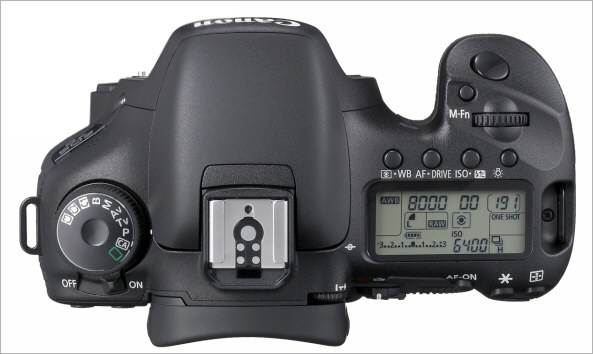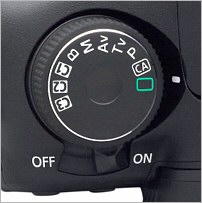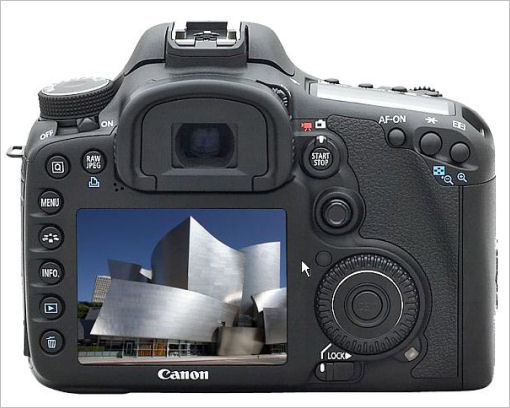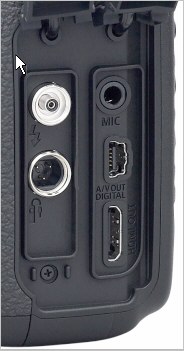

Canon EOS 7D Review - Controls
The control layout of the Canon EOS 7D is similar to that of the 50D, but with a few changes and the addition of a couple of new control buttons and dial settings. The top view of the EOS 7D is shown below:

On the left is the mode control dial with 10 settings. These are:
- C1, C2, C3 - Custom modes
- B - Bulb
- M - manual
- Av - Aperture Priority
- Tv - Shutter Priority
- P - Auto (intelligent) program
- CA - creative auto
- [] = Green Square - "P&S mode"
On the right of the camera is the monochrome LCD (which can be illuminated), along with buttons for ISO selection/FEC (flash exposure compensation), AF/Drive mode setting and metering mode/white balance setting.  With any one button the main control dial sets one parameter while the rear QCD (Quick control dial) sets the other. The main control dial is the wheel between the LCD and the shutter release. In Av mode it sets aperture, in Tv mode it sets shutter speed and it's used in setting various menu options.
With any one button the main control dial sets one parameter while the rear QCD (Quick control dial) sets the other. The main control dial is the wheel between the LCD and the shutter release. In Av mode it sets aperture, in Tv mode it sets shutter speed and it's used in setting various menu options.
The rightmost button in front of the LCD is used to illuminate the LCD with an orange backlight. The small wheel on the side of the eyepiece, to the left of the LCD is use to set the eyepiece diopter to compensate for near and far sighted users.
There are two new controls on the EOS 7D. First the "on/off" switch for camera power has moved from below the rear QCD is now located under the mode control dial on the left of the camera. Second there is a new M-fn button between the control dial and the shutter release button. "M-fn" stands for Multi-Function. Various operations can be assigned to this button included AE (auto exposure) lock, FE (flash exposure) loc. one touch RAW + JPEG and electronic level display.

The rear of the camera is dominated by the high resolution 3" LCD screen. The large dial to the right of the screen is the QCD (Quick Control Dial) and there is a "Set" button in the center which is used in setting various camera functions. The switch below the QCD allows the dial to be locked (electronically) in order to avoid accidentally changing settings if the QCD is turned. The QCD controls exposure compensation when shooting in Av and Tv modes and changes the aperture in manual mode (M). It's also used to scroll through the various camera menus.
There's a small multi-way controller just off the top right of the LCD screen. This is also used to navigate through the camera menus and control image position when reviewing images at high magnification.
Just above the multi-way controller and just to the left of the eyepiece is a new switch/button combination which controls Live view and Video operation. The switch selects between video and live view and the button starts/stops operation.
The 5 buttons immediately to the left of the LCD control are (from top to bottom):
- Menu - this brings up the camera control menus
- Picture Style - This allows selection of a picture style setting
- Info - This cycles through various information displays which can overlay or replace an image
- Playback - used to recall and image or movie
- Delete - used to delete files
To the right of the viewfinder are two buttons marked "Q" and "Raw/Jpeg". If the RAW/Jpeg button is pressed when the camera is set to record images in RAW mode, the next shot will be recorded as both a RAW and a JPEG file. Similarly if the camera is in Jpeg mode and the button is pressed, the next shot will be recorded as both a JPEG and a RAW file.
The "Q" button ("Q" stands for Quick Control Screen), displays the cameras operating parameters on the rear LCD and allows them to be changed using the rear QCD, the main control dial and the "Set" button (in the center of the QCD).
External Inputs/outputs
 Under two rubber covers on the left side of the camera are the external inputs and outputs. On the left are a PC connection for flash (max sync speed 1/250s, max sync voltage 250v) and a N3 type connection for a wired remote (such as the Canon RS-80N3.
Under two rubber covers on the left side of the camera are the external inputs and outputs. On the left are a PC connection for flash (max sync speed 1/250s, max sync voltage 250v) and a N3 type connection for a wired remote (such as the Canon RS-80N3.
On the right is a 3.5mm jack for an external stereo microphone or sound source for use in conjunction with video recording. Below that is a mini USB connector for connecting the camera to a computer or printer. Below that is a mini-HDMI (High Definition Multimedia Interface) connector for direct connection to a TV with an HDMI input. Note that an HDMI cable is not supplied by Canon with the EOS 7D.
On the front of the camera, right below the "7D" logo is the mono microphone used for video sound recording. The is a small speaker on the rear of the camera at the lower right corner of the viewfinder eyepiece which can be used to monitor playback of recorded audio.
On the right side of the camera is the door which gives access to the memory card slot. The EOS 7D accepts CompactFlash memory cards (Type I or II). It is compatible with UDMA enabled cards (up to mode 6 speed, but does not require them. UDMA cards will give faster operation under some conditions (e.g. continuous shooting). Like all DSLRs, the EOS 7D uses the FAT 32 file system, which imposes a 4GB limit on file size. This is of no consequence when shooting still images, but can be a limitation when recording video.
Viewfinder
The EOS 7D is the first EOS DSLR outside the 1D series to offer a 100% optical viewfinder. The viewfinder magnification is 1x and this results in the viewfinder screen of the 7D appearing slightly larger than that of the EOS 50D, but slightly smaller than that of the 5D MkII. There is a built in diopter adjustment so that near and far sighted users can adjust the focus for optimum sharpness.
One feature of the viewfinder that I haven't seen commented on elsewhere or document in the Canon literature is that the plastic housing around the viewfinder (which the rubber eye guard clips onto) is somewhat larger than that of the 20/30/40/50/5D. With those models I've used a Canon eyepiece magnifier (no longer available) to give a 2.5x magnification of the screen to assist in manual focusing. That eyepiece magnifier will not physically fit on the EOS 7D. Of course you can use Liveview and the built in 5x and 10x view on the rear LCD for manual focus, so perhaps eyepiece magnifiers are now "obsolete technology"!
NEXT: Operating speed, AF and Other Features
